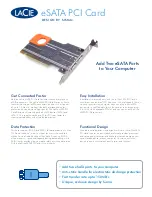
01010101100110101010110011010101011001101010101100110101010110011010101011001101010101100110
100110101010110011010101011001101010101100110101010110011010101011001101010101100110101010110011010101011011010101011
10101010110011010101011011010101001101010100110101101101101010100101
1011010101100110011010101011010101111010111
11010101101101010100111110
1101110110110011
0111011110
111101
011
11
1
Seagate
PC-3000 EXPRESS / UDMA / PORTABLE
F3 architecture
ACE Lab
Technical support: [email protected]
Phone: +7 863 201 50 06
20
ts.acelaboratory.com
Once the position of the hidden area relatively to UNC is identified, you should add the information about that area to
the translator using the defects editor of the utility.
Create in the list a defect record with the corresponding starting point and length, then invoke the 'Hide to Slip-List'
command from the shortcut menu (
). When the operation completes, user data up to the next "fork" will become
accessible for reading provided the hidden area has been selected correctly.
Fig. 5.9
The actual searching for the "fork" should be performed using the logical scanning test of the utility with verification
enabled ('
Tests → Logical test'). The maximum number of defects to be revealed before the test is stopped should be set
in the test options to 1. Thus the test will stop immediately at the supposed fork location enabling creation of a defects
list pointing to that LBA.
Attention!
Please keep in mind while analyzing the test results that apart from the translation "forks" the drive may
contain real bad blocks.
The case of "extra" defects is worth mentioning separately. Essentially, the problem is as follows. For some reason a
drive may have added to P-List or Non Resident G-List
additional defect records disrupting translation. Automatic
translator recovery procedure (both methods) additionally hides sectors in the process and thus obviously cannot "fix"
an area already containing sectors, which have been hidden in error. In that case you should try locating and removing
the extra records using both the data from surface obtained with regular reading and reading via the utility. The utility
provides the following opportunities for that purpose:
♦
P-List editing. The editor allows to extract from a drive the list of defects stored in P-List, and then use the
data from surface and the flags of defect records (in particular, records with the G-List -> P-List flag are
suspicious) to identify and remove the records disrupting translation. Please keep in mind that a single
defect record may describe a chain of sectors, some of which may belong to a correct list while the rest are
1
Meaning the records with the flag other than 0 (most frequently, 0x20), as the records with the 0 flag are removed
during translator recalculation based on P-List.
















































